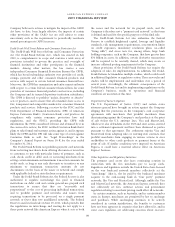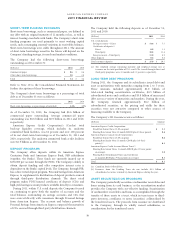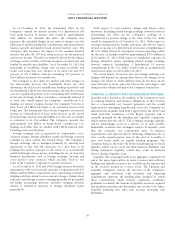American Express 2011 Annual Report Download - page 32
Download and view the complete annual report
Please find page 32 of the 2011 American Express annual report below. You can navigate through the pages in the report by either clicking on the pages listed below, or by using the keyword search tool below to find specific information within the annual report.
AMERICAN EXPRESS COMPANY
2011 FINANCIAL REVIEW
FUNDING PROGRAMS AND ACTIVITIES
The Company meets its funding needs through a variety of
sources, including direct and third-party distributed deposits and
debt instruments, such as senior unsecured debentures, asset
securitizations, borrowings through a secured financing facility
and long-term committed bank borrowing facilities in certain
non-U.S. regions.
The Company had the following consolidated debt and customer
deposits outstanding as of December 31:
(Billions) 2011 2010
Short-term borrowings $3.4$ 3.4
Long-term debt 59.6 66.4
Total debt 63.0 69.8
Customer deposits 37.9 29.7
Total debt and customer deposits $ 100.9 $ 99.5
The Company seeks to raise funds to meet all of its financing
needs, including seasonal and other working capital needs, while
also seeking to maintain sufficient cash and readily-marketable
securities that are easily convertible to cash, in order to meet the
scheduled maturities of all long-term funding obligations on a
consolidated basis for a 12-month period. Management does not
expect to make any major funding or liquidity strategy changes
in order to meet Basel III’s Liquidity Coverage Ratio standard.
The Company’s funding plan for the full year 2012 includes,
among other sources, approximately $3 billion to $9 billion of
unsecured term debt issuance and $1 billion to $6 billion of
secured term debt issuance. The Company’s funding plans are
subject to various risks and uncertainties, such as future business
growth, the impact of global economic, political and other events
on market capacity, demand for securities offered by the
Company, regulatory changes, ability to securitize and sell
receivables, and the performance of receivables previously sold in
securitization transactions. Many of these risks and uncertainties
are beyond the Company’s control.
The Company’s equity capital and funding strategies are
designed, among other things, to maintain appropriate and
stable unsecured debt ratings from the major credit rating
agencies, Moody’s Investor Services (Moody’s), Standard &
Poor’s (S&P), Fitch Ratings (Fitch) and Dominion Bond Rating
Services (DBRS). Such ratings help to support the Company’s
access to cost-effective unsecured funding as part of its overall
financing programs. The Company’s asset-backed securitization
(ABS) activities are rated separately.
Credit Agency Entity Rated
Short-Term
Ratings
Long-Term
Ratings Outlook
DBRS All rated entities R-1
(middle)
A
(high)
Stable
Fitch All rated entities F1 A+ Stable
Moody’s TRS(a)
and rated operating
subsidiaries
Prime-1 A2 Stable
Moody’s American Express
Company
Prime-2 A3 Stable
S&P All rated entities A-2 BBB+ Stable
(a) American Express Travel Related Services Company, Inc.
Downgrades in the Company’s unsecured debt or asset
securitization program’s securities ratings could result in higher
funding costs, as well as higher fees related to borrowings under
its unused lines of credit. Declines in credit ratings could also
reduce the Company’s borrowing capacity in the unsecured debt
and asset securitization capital markets. The Company believes
the change in its funding mix, which now includes an increasing
proportion of U.S. retail deposits insured by the Federal Deposit
Insurance Corporation (FDIC), should reduce the impact that
credit rating downgrades would have on the Company’s funding
capacity and costs. Downgrades to certain of the Company’s
unsecured debt ratings in the last several years have not
materially impacted the Company’s borrowing costs or resulted
in a reduction in its borrowing capacity.
30
























